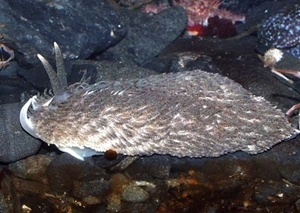Grey sea slug
 We are all familiar with the battle against slugs in our gardens, or the challenges they present to farmers across our terrestrial landscapes, but their close relatives are also part of our marine communities, as members of a fascinating and diverse group of marine molluscs found in our oceans.
We are all familiar with the battle against slugs in our gardens, or the challenges they present to farmers across our terrestrial landscapes, but their close relatives are also part of our marine communities, as members of a fascinating and diverse group of marine molluscs found in our oceans.
A few years back, a friend and I volunteered to do a ‘Shoresearch’ survey at Lee-on-the-Solent; rock pooling is always a fun activity, and even more so when you know your findings will contribute to local species records. Having walked the beach for a few hours identifying and learning about the weird and wonderful species of the intertidal zone, my friend called the group over to try to identify what he had found in a nondescript puddle on the sand. Even though relatively common, it turned out that we were in the presence of the first grey sea slug (Aeolidia papillosa) to be recorded in Hampshire!
The grey sea slug can be found around the British Isles and into the colder northern waters of Europe, and despite its name, can be found in a range of colours, including yellow, brown or purple at the base. It has a pair of rhinophores on the head and somewhat longer protruding oral tentacles, which help to sense their surroundings and provide protection.
All sea slugs are hermaphrodites, having male and female sexual organs, with the grey sea slug having a rather more straightforward act of copulation compared to some other species of sea slug, involving the simple transfer of a sperm packet. However, it seems reproduction in the sea slug world can border on the extraordinary, with one scientific paper referring to some sea slug copulation as ‘cephalon traumatic secretion transfer’, involving secretions being injected into the partner’s forehead!
Anyway, rapidly moving on…
Even though this species is only a quaint 12cm long when fully grown, it can lay up to 400,000 eggs on the underside of a rock, in a pretty ribbon pattern, usually between January and August. The larvae then disperse in plankton once hatched and are usually found in deeper depths until they reach adulthood.
This species is also part of a very interesting wider group of marine gastropod molluscs named nudibranchs, meaning ‘naked gill’ due to their breathing apparatus being on the outside of their soft bodies. Visually, many within this group are found to be in complete contrast to the grey sea slug’s beautiful yet slightly dull appearance, by displaying vivid psychedelic colours, hence adopting more fanciful names such as ‘clown’, ‘splendid’, ‘sea swallow’ and ‘Spanish dancer’.
Even though some host these fanciful names, nudibranchs are sometimes referred to as the ‘Thieves of the Sea’. Having lost their shells during the course of evolution, they have adapted various defence mechanisms such as camouflage and mimicry, but most impressively nudibranchs can actually harness the venom of their prey, such as that of the sea anemone. Though soft bodied, they can not only withstand the sting from a sea anemone for the chance of a meal but can impressively reproduce the anemone’s nematocyst stinging cells into its own body and use it for protection against predators, by recycling them into tentacle structures on their backs.
If this adaption is not remarkable enough, researchers at the University of Portsmouth are continuing to understand the predator-prey relationship between some nudibranch molluscs and their prey of hydroid colonies – a super organism, related to corals, consisting of polyps that capture and feed on plankton.
It has been found during the study that the nudibranchs act like pirates of the underworld, purposefully directing their attacks on polyps that have recently eaten, to loot their target’s meal. This relatively undocumented behaviour of using another species as a type of ‘fishing rod’ to access large sources of alternative prey, has been termed ‘kleptopredation’.
It is thought that this behaviour allows nudibranchs to reduce the number of hydroid polyps they consume overall but still allowing them to increase their energy levels through their prey’s abundant plankton contents. Cleverly, this ‘sustainable farming’ approach extends the life of the hydroid colonies in which nudibranchs ultimately depend on to feed, breed and hide. Now isn’t that a clever slug!
Jodie Case
Research